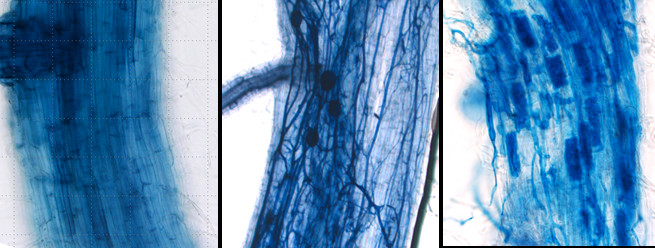Biotechnology and salinity tolerance of crops
PDFCultivating plants of agronomic interest irrigated with sea water while hoping for a high yield seems totally illusory at present. The objective of the scientific community is to offer biotechnological solutions to a major problem of food safety:
- Video 1:
For several years, research has been conducted to improve the salinity tolerance of plants. For example, engineering the expression and accumulation of compatible solutes has been experimented with some success in improving plant adaptation to salinity stress. However, these results achieved under very restricted conditions or at limited stages of development make this approach marginal.
Another avenue of engineering involves genetic manipulation of aquaporin expression to increase tolerance to salinity stress. As transport systems involved in the entry of water through the plasma membrane, aquaporins should play a major role in this context:
- Video 2:
Unfortunately, several attempts have not yielded conclusive results. For example, if plasma membrane aquaporin is expressed at high levels in transgenic rice plants, these plants have been shown to be sensitive to salinity stress, whereas those expressing the same aquaporin at medium to low levels have been shown to be more tolerant.
This result suggests that finely regulated aquaporin expression in tissues and over time may be more relevant for the engineering of salt stress tolerance. Moreover, the intrinsic water transport capacity of roots is strongly altered in the early stages of saline stress in several crop species, such as barley, rice, but also in Arabidopsis [1]. This alteration is thought to be related to the inhibition of the water transport activity of aquaporins minimizing counter-flow, i.e. the loss of water from the intracellular medium to the outside (soil). There is no doubt that aquaporins play a role in the response to saline stress, but this has yet to be clarified.
The genomic approaches that have already led to major discoveries must be continued. In particular, genome-wide association studies [2] seem to be the most promising when there is a large natural variation in the tolerance/sensitivity to saline stress in the plant of agronomic interest. To this end, phenotyping of large collections that have been built up beforehand makes it possible to isolate the natural allelic variation at a given locus responsible for morphological or functional traits controlling adaptation to salinity for a given environment.
Agronomists are thus in search of ideotypes [3], cultivars adapted to the salinity of their environment (meteorological, pedological, …). Alleles of particular interest for salinity tolerance found in a low-yielding variety can then be introgressed [4] into elite cultivars to combine the tolerance trait with high yield or other qualities. Numerous introgression programs of the Saltol locus are currently in progress [5].
A better understanding of the mechanisms that allow halophytes to grow in salt-rich environments should also be able to improve salinity tolerance in glycophytes. Translational research aimed at translating fundamental knowledge in botany, for example, into concrete applications in applied research can be based on various mechanisms combining:
- anatomical adaptations (reinforced apoplastic barriers made of suberin preventing salt from penetrating inside the root, glands excreting salt out of the leaf tissue, …) ;
- salt compartmentalization (accumulation of Na+ in the leaf sheath protecting the photosynthesis that takes place in the leaf blade) ;
- the vacuolar confinement of Na+ and its effective exclusion/recirculation by the action of transport systems.
Finally, it is necessary to integrate the beneficial interactions that plants have with soil micro-organisms, especially rhizosphere bacteria and mycorrhizal fungi (Figure 1) (See Symbiosis and Parasitism). The latter allow, among other things, better nutrition of nutrients and water. In addition, more and more studies are documenting the beneficial effect of microorganisms on tolerance to salt stress in crops of agronomic interest.

Notes and References
Cover image. Mutual symbiosis between rice and Rhizophagus irregularis, an arbuscular mycorrhizal fungus [Source: © Pierre-Alexandre Audebert]
[1] Boursiac Y., Chen S., Luu D.-T., Sorieul M., van den Drie N. & Maurel C. 2005. Early Effects of Salinity on Water Transport in Arabidopsis Roots. Molecular and Cellular Features of Aquaporin Expression. Plant Physiology 139, 790-804 – DOI: https://doi.org/10.1104/pp.105.065029
[2] https://en.wikipedia.org/wiki/Genome-wide_association_study
[3] https://en.wikipedia.org/wiki/Ideotype
[4] https://en.wikipedia.org/wiki/Introgression
[5] http://www.knowledgebank.irri.org/ricebreedingcourse/Breeding_for_salt_tolerance.htm




